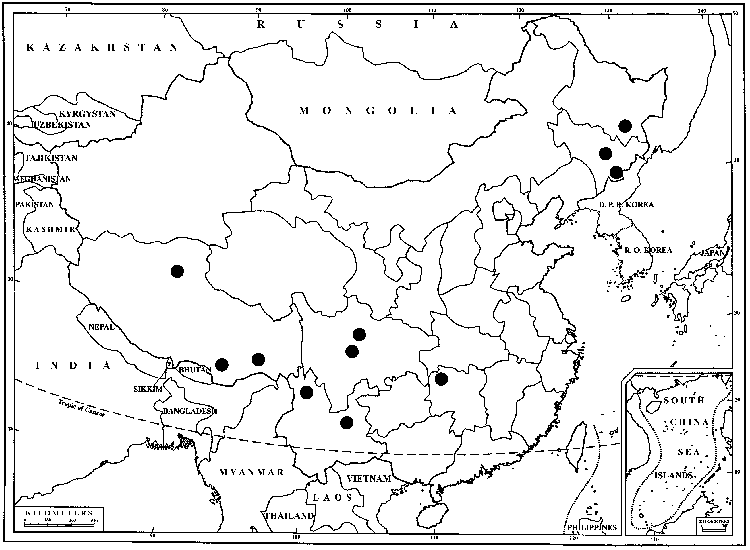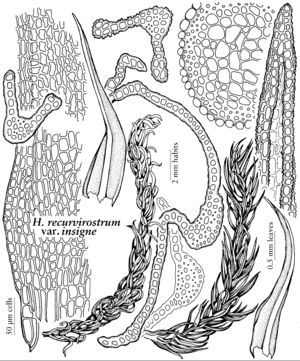Hymenostylium recurvirostrum var. insigne
Philipp. J. Sci. 68: 106. 1939,.
Stem hyalodermis present. Leaves sometimes more densely arranged along the stem than the typical variety, with a comal tuft; erect to weakly spreading when dry, squarrose-recurved when wet, (1.6–) 2–2.4 mm, margins broadly recurved proximally, often 2-stratose in more or less extensive patches, base rectangular, flaring, with shoulders.
Phenology: Capsules unknown, although eroded setae present in some specimens.
Habitat: Wet, limey cliffs
Elevation: low to moderate elevations (0-1000 m)
Distribution

B.C., South America (Peru), w Europe (Scotland), w Europe (Spain), Asia (China)
Discussion
In the flora area, var. insigne is known only from British Columbia at Bridal Veil Falls in the Fraser Valley, and Moresby Island of the Queen Charlotte Islands. It is essentially a more massively developed version of the typical variety and intermediate characters can be demonstrated in some specimens. The variety can only be identified with confidence when all characters are present: a larger, more well-developed costa, the occurrence of 2-stratose patches marginally distally on the leaves, the relatively long stems, long leaves, broad leaf base with broadly and flabbily recurved margins, long-acuminate apex acuminate into a conical apiculus. Perhaps the best character of var. insigne is the extremely thick sclerodermis, the thick-walled hyalodermis and histologically robust costa in section. The distal cells of var. insigne have been described as being smooth, but they are papillose in many specimens, including the type from Scotland. Laminal papillae are present in specimens in the flora and when apparently absent they may often be detected in cross section in the unevenness of the ad- and abaxial lumen walls. They are less like the single, sharp papillae of var. recurvirostrum, but are often much lower, 2-fid or scablike. R. H. Zander and P. M. Eckel (1982) presented a comparative morphological analysis of taxa related to or varieties of H. recurvirostrum from several countries and demonstrated the intergrading character of var. insigne and var. recurvirostrum. Variety insigne is an example of gigantism common in the moss flora of hyperoceanic British Columbia, seen also in Gymnostomum aeruginosum and Tortella humilis. The variety resembles Didymodon fallax in its large, long-lanceolate leaves, with flaring bases and broadly recurved margins. Didymodon giganteus has elongate irregular laminal cells. Both species have stem central strands, as is the case in the genus Didymodon. The basal cells are also very thick-walled and irregularly thickened, resembling those of species of Grimmia. Variety insigne might be confused with Amphidium mougeotii, which differs by the tiny, oval laminal papillae organized pole to pole in longitudinal lines, often clearly evident on the leaf base and giving a “granular” appearance to the leaf cells.
Selected References
None.
